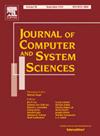用Weisfeiler-Leman论群同构的并行复杂性
IF 0.9
3区 计算机科学
Q1 BUSINESS, FINANCE
引用次数: 0
摘要
我们利用群的Weisfeiler-Leman算法(Brachter & Schweitzer, LICS 2020)来提高几个群族同构测试的并行复杂度上界。我们首先证明了具有补为O(1)-生成的Abelian正规Hall子群的群是用O(1)-轮由常维weisfeiller - leman识别的。这就把这个群族的同构检验放到了L中;以前同构检验的上界为P (Qiao, Sarma, & Tang, STACS 2011)。接下来,我们使用个性化和细化范式,通过深度为O(log (n))和大小为nO(log (n))的SAC电路,获得了没有阿贝尔正规子群的群的同构检验,以前只知道在P (Babai, Codenotti, & Qiao, ICALP 2012)和准isac1 (Chattopadhyay, Torán, & Wagner, ACM Trans)中存在。第一版。理论,2013)。接下来,我们将Brachter &; Schweitzer (ESA, 2022)关于群的直接积的结果扩展到平行设置。也就是说,如果Weisfeiler-Leman能并行地识别每个不可分解的直接因子,我们就能并行地识别直接产物。我们最后考虑无计数的Weisfeiler-Leman算法,其中我们表明无计数的WL甚至无法在多项式时间内区分阿贝尔群。尽管如此,我们将无计数WL与有界不确定性和有限计数相结合,获得了用于阿贝尔群同态检验的β1MAC0(FOLL)的新上界。这改进了之前由于Chattopadhyay, Torán, & Wagner (ACM Trans.)提出的TC0(FOLL)上界。第一版。理论,2013)。本文章由计算机程序翻译,如有差异,请以英文原文为准。
On the parallel complexity of group isomorphism via Weisfeiler–Leman
We leverage the Weisfeiler–Leman algorithm for groups (Brachter & Schweitzer, LICS 2020) to improve parallel complexity upper bounds on isomorphism testing for several families of groups. We first show that groups with an Abelian normal Hall subgroup whose complement is -generated are identified by constant-dimensional Weisfeiler–Leman using -rounds. This places isomorphism testing for this family of groups into ; the previous upper bound for isomorphism testing was (Qiao, Sarma, & Tang, STACS 2011). We next use the individualize-and-refine paradigm to obtain an isomorphism test for groups without Abelian normal subgroups by circuits of depth and size , previously only known to be in (Babai, Codenotti, & Qiao, ICALP 2012) and (Chattopadhyay, Torán, & Wagner, ACM Trans. Comput. Theory, 2013). We next extend a result of Brachter & Schweitzer (ESA, 2022) on direct products of groups to the parallel setting. Namely, we how that Weisfeiler–Leman can identify direct products in parallel, provided it can identify each of the indecomposable direct factors in parallel. They previously showed the analogous result for . We finally consider the count-free Weisfeiler–Leman algorithm, where we show that count-free WL is unable to even distinguish Abelian groups in polynomial-time. Nonetheless, we use count-free WL in tandem with bounded non-determinism and limited counting to obtain a new upper bound of for isomorphism testing of Abelian groups. This improves upon the previous upper bound due to Chattopadhyay, Torán, & Wagner (ACM Trans. Comput. Theory, 2013).
求助全文
通过发布文献求助,成功后即可免费获取论文全文。
去求助
来源期刊

Journal of Computer and System Sciences
工程技术-计算机:理论方法
CiteScore
3.70
自引率
0.00%
发文量
58
审稿时长
68 days
期刊介绍:
The Journal of Computer and System Sciences publishes original research papers in computer science and related subjects in system science, with attention to the relevant mathematical theory. Applications-oriented papers may also be accepted and they are expected to contain deep analytic evaluation of the proposed solutions.
Research areas include traditional subjects such as:
• Theory of algorithms and computability
• Formal languages
• Automata theory
Contemporary subjects such as:
• Complexity theory
• Algorithmic Complexity
• Parallel & distributed computing
• Computer networks
• Neural networks
• Computational learning theory
• Database theory & practice
• Computer modeling of complex systems
• Security and Privacy.
 求助内容:
求助内容: 应助结果提醒方式:
应助结果提醒方式:


